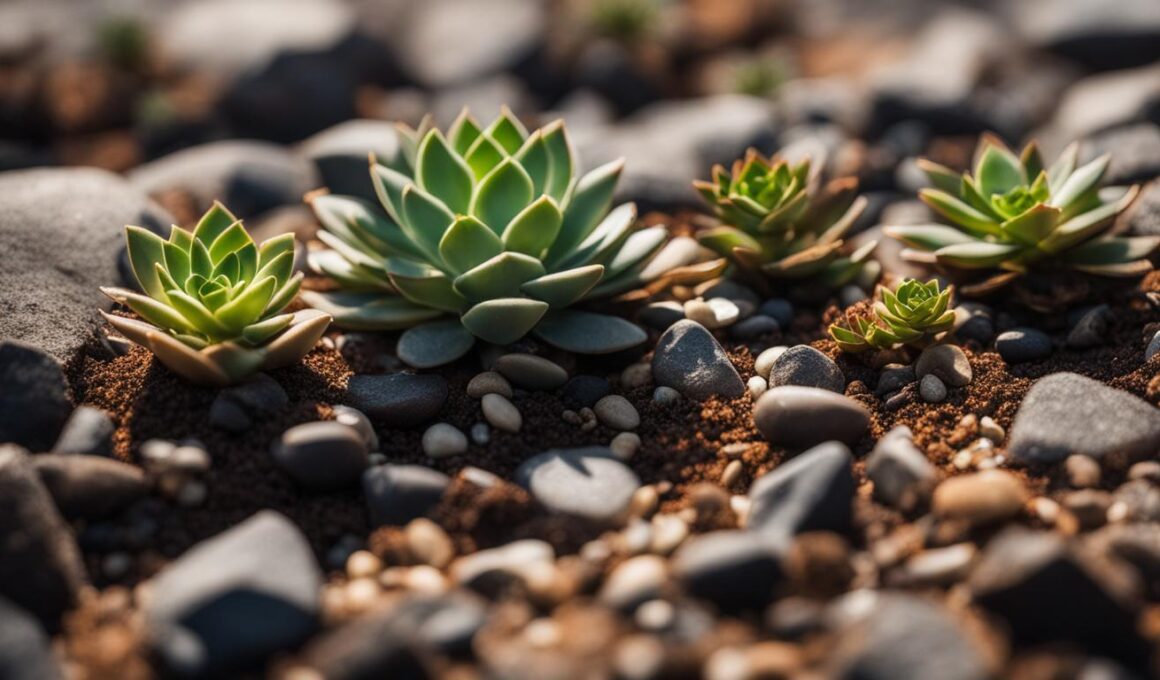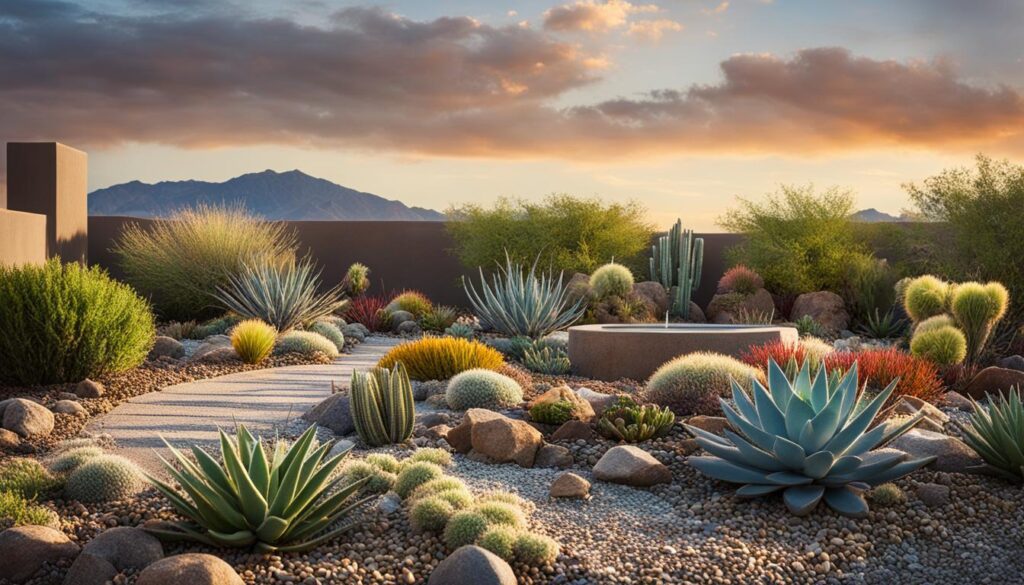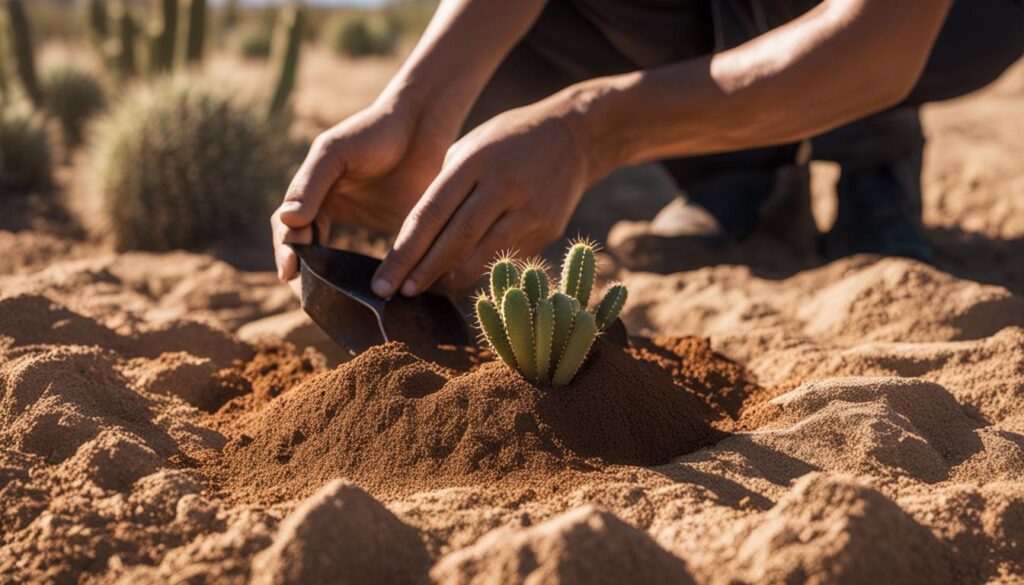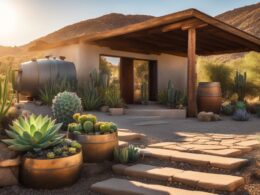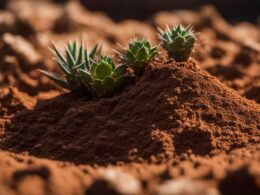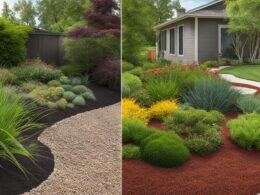Xeriscape landscaping is a popular method for creating a unique and water-efficient yard. By using drought-tolerant soil mix, you can conserve water and still have a stunning landscape. This article will explore the benefits of xeriscaping, the principles to follow, who can benefit from xeriscaping, the cost of xeriscape landscaping, and how to xeriscape your yard on a budget.
Key Takeaways:
- Drought-tolerant soil mix is essential for water-efficient xeriscape landscaping.
- Xeriscaping can help conserve water and create beautiful landscapes.
- Following the seven principles of xeriscaping can result in a sustainable yard.
- Residents in drought-prone areas can benefit the most from xeriscaping.
- Xeriscape landscaping can be done on a budget with DIY techniques and cost-effective choices.
What Is Xeriscaping?
Xeriscaping is a drought-tolerant landscaping method that aims to use as little water as possible to maintain a yard. It is particularly popular in drought-prone areas. By incorporating efficient irrigation, mulching, and using drought-tolerant plants, xeriscaping can reduce water usage for your yard by 50%. Additionally, replacing traditional lawns with turf alternatives can increase your return on investment (ROI) by 10-15%. Xeriscaping is a low-maintenance way to keep your yard beautiful and can also benefit local wildlife by using native plants.
Efficient Use of Water
The key principle of xeriscaping is to minimize water usage for landscaping purposes. By using drought-tolerant plants, which have evolved to survive in arid conditions, you can significantly reduce the amount of water required to keep your yard healthy and vibrant. These plants have adapted features such as deep root systems, waxy leaves, and water-storing tissues that enable them to thrive in dry climates.
Furthermore, xeriscaping promotes efficient irrigation practices, such as drip irrigation or soaker hoses, which deliver water directly to the roots of plants, minimizing wastage due to evaporation or runoff. By optimizing watering schedules and using soil amendments that improve water retention, you can maximize the efficiency of your irrigation system and minimize water waste.
Turf Alternatives
Another important aspect of xeriscaping is the use of turf alternatives. Traditional lawns require vast amounts of water to maintain their lush appearance, making them unsustainable in arid regions. Xeriscaping encourages the use of alternative ground covers, such as native grasses, wildflowers, gravel, or decorative rocks, which not only reduce water consumption but also provide unique and visually appealing landscapes.
Turf alternatives offer several advantages. They require less water, minimal maintenance, and are resistant to pests and diseases. Additionally, they are more resilient to drought conditions and can withstand foot traffic, making them suitable for areas that experience heavy use, such as playgrounds or recreational spaces.
By embracing xeriscaping and incorporating drought-tolerant plants and turf alternatives into your landscaping design, you can create a sustainable, low-water landscape that is not only visually striking but also environmentally friendly.
The 7 Principles of Xeriscaping
Xeriscaping is a landscaping technique that promotes water conservation and sustainability. By following these seven principles, you can create an eco-friendly and low-maintenance xeriscape landscape that thrives even in drought-prone areas.
1. Planning and Design
Start by evaluating your yard’s needs and determining the desired look and functionality of your xeriscape landscape. Consider factors such as sun exposure, soil quality, and water availability. Create a detailed plan, including the placement of plants, paths, and other elements.
2. Soil Improvements
Prepare your soil by improving its water-holding capacity and fertility. Add organic matter, such as compost, to improve soil structure and moisture retention. This helps plants access water more efficiently and reduces the need for irrigation.
3. Efficient Irrigation
Implement efficient irrigation methods to minimize water waste. Consider using drip irrigation or soaker hoses, which deliver water directly to the root zones of plants. Group plants with similar water needs together to ensure proper watering.
4. Plant Zones
Create distinct zones based on each plant’s water and sunlight requirements. Group plants with similar needs together, allowing for more efficient irrigation and preventing water stress. Choose native and drought-tolerant plants that can thrive in your climate.
5. Mulches
Use mulches, such as wood chips or gravel, to cover bare soil and prevent water evaporation and weed growth. Mulching also helps regulate soil temperature and conserves moisture, reducing the need for frequent watering.
6. Turf Alternatives
Consider replacing traditional lawns with turf alternatives, such as native grasses or groundcovers. These alternatives require less water and maintenance, and can still provide a lush and attractive landscape. Consult with local experts to choose the best options for your region.
7. Maintenance
Maintain your xeriscape landscape by practicing regular maintenance tasks. This includes weeding to prevent competition for water, pruning to promote healthy growth, and refreshing mulch as needed. Regularly monitor and adjust irrigation to ensure plants receive adequate water without waste.
| Principle | Description |
|---|---|
| Planning and Design | Create a detailed plan for your xeriscape landscape, considering factors like sun exposure and water availability. |
| Soil Improvements | Improve soil structure and moisture retention by adding organic matter like compost. |
| Efficient Irrigation | Use methods like drip irrigation or soaker hoses to minimize water waste and ensure proper watering. |
| Plant Zones | Create distinct planting zones based on each plant’s water and sunlight requirements. |
| Mulches | Cover bare soil with mulch to prevent water evaporation and weed growth. |
| Turf Alternatives | Consider replacing traditional lawns with native grasses or groundcovers that require less water and maintenance. |
| Maintenance | Regularly maintain your xeriscape landscape through tasks like weeding, pruning, and adjusting irrigation. |
Who Benefits From Xeriscaping?
Xeriscaping is a landscaping method that offers numerous benefits, particularly for those living in drought-prone areas. By implementing xeriscaping techniques, you can conserve water, create a visually appealing landscape, and enjoy a lower water bill. But xeriscaping isn’t just limited to regions with water scarcity; anyone can benefit from this sustainable landscaping approach.
Xeriscaping Benefits
The primary advantage of xeriscaping is water conservation. By utilizing drought-tolerant plants, minimizing water usage, and applying efficient irrigation methods, xeriscaping significantly reduces water consumption compared to traditional landscaping. This is especially crucial in areas where water resources are limited or during drought seasons.
In addition to water conservation, xeriscaping has other positive impacts. It promotes the preservation of local ecosystems and wildlife by utilizing native plants, which are well-adapted to the local environment. Xeriscaping also contributes to reducing the carbon footprint, as it requires less mowing and eliminates the need for chemical fertilizers and pesticides.
Drought-Prone Areas
Residents in drought-prone states such as California, Arizona, Nevada, and Colorado can benefit greatly from xeriscaping. These regions often face water scarcity and strict water regulations, making xeriscaping an ideal solution. By implementing xeriscaping techniques, homeowners can maintain a beautiful landscape while reducing their water usage and complying with local water restrictions.
However, it’s important to note that xeriscaping is not limited to these areas. No matter where you live, adopting xeriscaping principles is a responsible choice. Water conservation is essential, as only a small percentage of the Earth’s water is fresh and available for human use. By reducing your water consumption through xeriscaping, you not only contribute to the environment’s well-being but also save money on your water bill.
| Xeriscaping Benefits | Drought-Prone Areas |
|---|---|
| Water conservation | California |
| Promotes local ecosystems | Arizona |
| Reduces carbon footprint | Nevada |
| Low maintenance | Colorado |
Overall, xeriscaping is a sustainable and practical landscaping approach that benefits both individuals and the environment. Whether you live in a drought-prone area or simply wish to conserve water and create an eco-friendly landscape, xeriscaping provides a cost-effective and visually appealing solution. By embracing xeriscaping principles and drought-tolerant plants, you can enjoy a beautiful, water-efficient yard while making a positive impact on the planet.
The Cost of Xeriscaping
Xeriscaping your yard can provide numerous benefits, including water conservation and creating a beautiful, sustainable landscape. However, one factor that homeowners often consider is the cost of xeriscape landscaping. The cost can vary depending on whether you hire a professional landscaping company or choose to DIY the project.
If you decide to hire a professional landscaper, the cost of xeriscaping can range from $5 to $20 per square foot. For example, for a 1,200-square-foot yard, you can expect to pay around $17,000, while a 500-square-foot yard would cost approximately $6,000. The cost may include the design, labor, materials, and any additional features you choose to incorporate into your xeriscape landscape.
However, if you’re on a budget, you can still achieve a stunning xeriscape yard by DIY landscaping. By designing your own backyard and doing the physical labor yourself, you can save on professional fees. Additionally, choosing cost-effective elements like shells and pebbles instead of expensive hardscaping materials can help reduce costs. Utilizing seeds and plant cuttings instead of purchasing new plants can also be a budget-friendly option.
| Cost Factors | Professional Landscaping | DIY Landscaping |
|---|---|---|
| Labor | Included | DIY or helpers |
| Design | Included | DIY |
| Materials | Included | Purchase yourself |
| Additional Features | Extra cost | Depends on chosen features |
Furthermore, some states offer turf replacement rebates, which can help offset the cost of xeriscape landscaping. These rebate programs incentivize homeowners to remove traditional lawns and replace them with water-wise alternatives. If your state provides such a program, you can save even more on your xeriscape project.
In conclusion, the cost of xeriscaping can vary depending on whether you choose professional landscaping or DIY. However, with careful planning, cost-effective choices, and potential rebates, creating a budget-friendly xeriscape yard is achievable. By investing in xeriscaping, you can enjoy long-term savings on your water bill and contribute to water conservation efforts in your area.
How to Xeriscape on a Budget
Creating a budget-friendly xeriscape doesn’t have to be daunting. With a little creativity and planning, you can achieve a beautiful and sustainable landscape without breaking the bank. Here are some tips and ideas for DIY xeriscaping that will help you save money while creating an environmentally-friendly yard.
Design and Labor
One of the best ways to save on xeriscape landscaping is to design your own backyard. Take the time to research and plan your layout, considering the water and sunlight needs of the plants you choose. If you’re not confident in your design skills, there are plenty of free online resources and software available to help you create a professional-looking landscape plan.
When it comes to the physical labor, enlist the help of friends or family members. Organize a weekend work party and make it a fun and rewarding experience. By doing the labor yourself, you can save a significant amount of money that would have otherwise gone into hiring professional landscapers.
Utilize Cost-Effective Elements
Instead of investing in expensive concrete slabs and boulders, consider using cost-effective elements like shells and pebbles to add visual interest to your xeriscape. Not only are they more affordable, but they also provide excellent ground cover and help retain moisture in the soil.
Make your own mulch using materials such as shredded leaves, wood chips, or grass clippings. Mulch not only helps conserve moisture but also adds a finished look to your landscape. By making your own mulch, you can significantly reduce the cost of purchasing it from a store.
Turf Replacement Rebates
Many states offer turf replacement rebates as an incentive to conserve water. These programs provide financial incentives for homeowners who replace their traditional lawns with water-efficient alternatives. By taking advantage of these rebates, you can offset the cost of materials and plants needed for your xeriscape project.
Check with your local water district or municipality to see if they offer any rebate programs. Each program may have different requirements and limitations, so be sure to familiarize yourself with the guidelines before starting your xeriscaping project.
Cost-Saving Benefits
Implementing a budget-friendly xeriscape not only helps you save money upfront but also offers long-term cost-saving benefits. With a xeriscape, you’ll significantly reduce your water usage, resulting in lower water bills. Additionally, xeriscapes require less maintenance compared to traditional lawns, which translates into less time and money spent on mowing, fertilizing, and watering.
By following these budget-friendly tips and utilizing cost-effective elements, you can create a stunning xeriscape landscape without breaking the bank. With a little planning and effort, you’ll enjoy the beauty of a water-efficient yard while saving money in the process.
Applying Drought-Tolerant Soil Mix
When it comes to xeriscaping, applying drought-tolerant soil mix is a crucial step in creating a water-efficient and thriving landscape. By preparing the soil properly, regrading your yard, testing the soil, and adding mulch, you can create an optimal environment for your xeriscape plants.
Preparing the Soil
Before applying the drought-tolerant soil mix, it’s important to prepare the soil by regrading your yard. This helps prevent water pooling and allows for proper drainage. Use a rake or shovel to level your yard and create a slope that will direct water away from your home and towards the desired areas of your landscape.
Testing the Soil
Testing the soil is another crucial step in xeriscaping. A soil test will provide valuable information about its composition, pH levels, and nutrient content. This information will help you determine which amendments, such as organic compost or mulch, are needed to improve the soil’s water retention capabilities.
Adding Mulch
Adding mulch to your xeriscape landscape is an effective way to conserve moisture and suppress weed growth. Apply a layer of mulch around plants, leaving a small space around the stem or trunk to prevent rot. Mulch also helps regulate soil temperature and protects the roots of your xeriscape plants from extreme weather conditions.
| Advantages of Applying Drought-Tolerant Soil Mix | Disadvantages of Neglecting Soil Preparation |
|---|---|
| Enhances water retention capabilities | Poor water drainage, leading to waterlogging |
| Improves soil structure and aeration | Nutrient deficiencies, hindering plant growth |
| Reduces water runoff and erosion | Increased weed growth, competing for resources |
| Provides a stable and healthy environment for plant roots | Stunted plant growth and reduced plant vigor |
By applying drought-tolerant soil mix, preparing the soil, regrading your yard, testing the soil, and adding mulch, you are setting the foundation for a successful xeriscape landscape. These steps will enhance water retention, improve soil structure, reduce erosion, and provide a stable environment for your xeriscape plants to thrive.
Efficient Irrigation Methods
Efficient irrigation is crucial for water conservation in xeriscaping. By implementing the right irrigation techniques, you can minimize water waste and ensure that your plants receive the optimal amount of moisture. Two popular methods for efficient irrigation in xeriscaping are drip irrigation and soaker hoses.
Drip Irrigation
Drip irrigation is a highly efficient method that delivers water directly to the root zones of plants. By using a network of tubes with small emitters, water is applied slowly and directly at the plant’s base. This targeted approach minimizes evaporation and reduces water loss due to runoff. Additionally, drip irrigation allows for precise control of the amount of water each plant receives, ensuring that every drop is used efficiently.
Soaker Hoses
Soaker hoses are another effective option for efficient irrigation. These hoses have tiny pores along their length, allowing water to seep out slowly and evenly. When placed at the base of plants, soaker hoses provide a consistent and gentle soaking, promoting deep root growth and minimizing water waste. Soaker hoses are particularly useful for watering large areas or rows of plants, as they can be easily laid out and connected to a water source.
When implementing efficient irrigation methods, it’s important to consider the specific needs of your plants. Some plants may require more or less water than others, and your irrigation system should be tailored accordingly. Additionally, ensure that your system is properly maintained and regularly checked for leaks or clogs to maximize efficiency.
Table: Comparison of Drip Irrigation and Soaker Hoses
| Criteria | Drip Irrigation | Soaker Hoses |
|---|---|---|
| Water Delivery | Delivers water directly to the root zones of plants. | Provides a slow and even soaking along the length of the hose. |
| Water Efficiency | Highly efficient as water is targeted at the plant’s base, minimizing evaporation and runoff. | Efficient, but may result in some evaporation if left exposed to the sun. |
| Customization | Allows for precise control of water delivery to individual plants. | Can be easily laid out and connected to water source to cover large areas or rows of plants. |
| Maintenance | Requires regular maintenance to check for leaks or clogs. | Requires minimal maintenance but should be periodically checked for leaks. |
Implementing efficient irrigation methods is essential for conserving water in your xeriscape landscape. Whether you choose drip irrigation or soaker hoses, both options provide targeted and controlled water delivery, minimizing waste and ensuring that your plants thrive. By using these methods, you can contribute to water conservation efforts while enjoying a beautiful and sustainable yard.
Choosing Drought-Tolerant Plants
When creating a xeriscape landscape, it is crucial to choose drought-tolerant plants that can thrive with minimal water. By selecting the right plants for your climate and soil conditions, you can ensure a beautiful and water-efficient yard. Here are some key considerations for plant selection:
- Native Plants: Native plants are well-suited to the local climate and require less water and maintenance compared to non-native species. They have evolved to adapt to the specific conditions of your region and can thrive with minimal water resources. Incorporating native plants into your xeriscape landscape not only saves water but also supports the local ecosystem.
- Drought-Tolerant Varieties: Look for plant varieties that are known for their drought tolerance. These plants have developed mechanisms to survive in arid environments and are naturally adapted to conserving water. Examples of drought-tolerant plants include lavender, yucca, agave, and certain succulents.
- Low-Water Use Plants: Choose plants that have low water requirements. These plants can withstand dry periods and require less frequent watering. Mediterranean and desert plants, such as rosemary, cacti, and ornamental grasses, are excellent choices for low-water use gardens.
By carefully selecting drought-tolerant plants, you can create a xeriscape landscape that is both visually appealing and water-efficient. Remember to group plants together based on their water and sunlight needs to optimize irrigation and maximize water conservation.
Example Drought-Tolerant Plant Selection:
| Plant Name | Water Requirements | Height | Plant Type |
|---|---|---|---|
| Lavender | Low | 1-3 feet | Perennial |
| Yucca | Low | 3-8 feet | Perennial |
| Agave | Low | 1-6 feet | Succulent |
| Rosemary | Low | 1-3 feet | Herb |
| Cacti | Low | Varies | Succulent |
| Ornamental Grasses | Low | Varies | Perennial |
Xeriscaping Maintenance
Maintaining a xeriscape landscape is generally low-maintenance, but there are still important tasks to consider to keep your yard looking its best. Regular weeding is essential to prevent competition for water and nutrients. Remove any weeds promptly to ensure they don’t overtake your drought-tolerant plants. By staying on top of weeding, you can maintain the aesthetic appeal of your xeriscape landscape.
Another important aspect of xeriscape maintenance is mulch upkeep. Mulch helps retain moisture in the soil, suppresses weed growth, and improves the overall appearance of your yard. Check the mulch regularly and replenish it as needed to ensure optimal moisture retention and weed prevention.
Additionally, pruning and maintaining your xeriscape plants as necessary is crucial for their health and appearance. Trim back any dead or overgrown branches, and remove any diseased foliage to prevent the spread of pests or diseases. Regular pruning will promote healthy growth and longevity of your drought-tolerant plants.
Benefits of Xeriscaping and Water Conservation
Xeriscaping offers numerous benefits, including water conservation, reduced strain on water resources, and promoting resilience in the face of changing weather patterns. By conserving water, we can maintain healthy ecosystems and protect wildlife. Xeriscaping also helps reduce the need for water treatment, lowers energy consumption, and decreases the demand for treating and managing wastewater. Implementing xeriscaping techniques in your yard not only benefits the environment but also contributes to energy savings and lower utility bills.
One of the key benefits of xeriscaping is water conservation. Xeriscape landscapes are designed to minimize water usage by incorporating efficient irrigation methods, using drought-tolerant plants, and improving soil moisture retention. By reducing water consumption, xeriscaping helps alleviate the strain on water resources, particularly in areas prone to drought.
Additionally, xeriscaped yards are more resilient to changing weather patterns. With climate change leading to more frequent and severe droughts, xeriscaping provides a sustainable solution for maintaining beautiful landscapes even in dry conditions. By selecting drought-tolerant plants and implementing efficient irrigation techniques, xeriscaped yards can thrive with minimal water requirements.
Furthermore, xeriscaping has a positive environmental impact. By conserving water, xeriscaping helps protect natural ecosystems and preserves local habitats for wildlife. It also reduces the need for water treatment, which saves energy and minimizes the release of pollutants into the environment. By choosing xeriscaping for your yard, you can actively contribute to a greener and more sustainable future.
| Environmental Benefits of Xeriscaping | Energy Savings |
|---|---|
| Conserves water resources and maintains healthy ecosystems | Minimizes energy consumption associated with water treatment |
| Reduces strain on water supplies in drought-prone areas | Decreases demand for treating and managing wastewater |
| Promotes resilience to changing weather patterns |
Conclusion
Xeriscaping with drought-tolerant soil mix is a practical and sustainable solution for creating water-efficient yards. By following the principles of xeriscaping, choosing drought-tolerant plants, and implementing efficient irrigation methods, you can conserve water while still enjoying a beautiful and sustainable landscaping design.
Whether you live in a drought-prone area or simply want to reduce your environmental impact, xeriscaping is a beneficial landscaping approach. By incorporating efficient irrigation techniques, mulching, and selecting appropriate plants, you can create a yard that not only conserves water but also enhances the beauty of your outdoor space.
With xeriscaping, you can transform your yard into a water-efficient landscape that requires minimal maintenance. By embracing these practices, you contribute to the preservation of water resources and reduce your overall ecological footprint. So, start implementing xeriscaping techniques and enjoy the beauty and water-saving benefits of a xeriscape landscape today!





